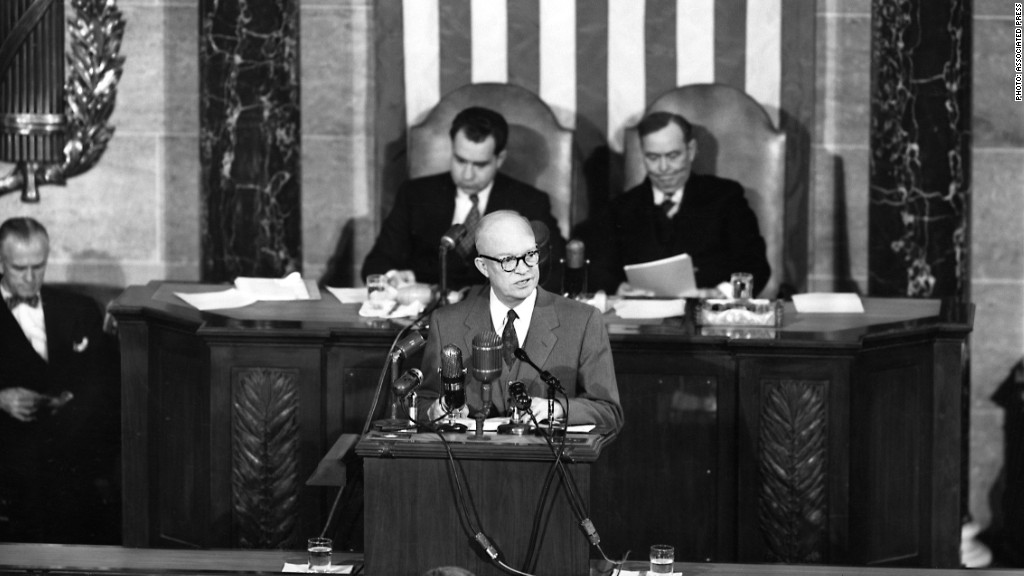
Can threats to block a debt ceiling increase ever be justified as a tool to force politicians to make difficult but necessary decisions?
Republicans seem to think so. GOP leaders say they want spending cuts before raising the $16.699 trillion debt limit, which the Obama administration says has to be done before the middle of next month. And some Republicans are holding a gun to the head of Obamacare as well.
The idea of using the debt ceiling for leverage is not new. Indeed, it caused the nation's first debt limit crisis.
(Timeline: Washington's budget follies)
In the summer of 1953, President Dwight Eisenhower, a Republican, asked for a modest boost in the debt ceiling, from $275 billion to $290 billion. Austerity-minded lawmakers refused and brought the nation to the brink of default -- or to its fiscal senses, depending on your point of view.
Eisenhower began signaling the need for additional borrowing authority shortly after taking office. Conservatives were not convinced. The Wall Street Journal even suggested a debt ceiling crisis might be useful: "The government would not be able to carry out all of its spending plans," the editors predicted. "Some things would have to be cut back a little further."
But Eisenhower didn't believe that spending cuts would be sufficient to keep federal debt under the cap for long. "Despite our joint vigorous efforts to reduce expenditures," he told Congress, "it is inevitable that the public debt will undergo some further increase."
The House of Representatives swallowed hard and approved Eisenhower's request. But the Senate had other ideas.
(Related: The debt ceiling explained)
Harry F. Byrd, the Democratic senator from Virginia, took the lead in fighting the increase. Raising the limit would be "an invitation to extravagance," he declared. Keeping the present cap, moreover, would encourage much-needed economy. "It may be that the administration would be forced to operate on a very prudent and conservative budget in order to avoid an increase in the debt limit," he predicted.
But Eisenhower's request had considerable support outside the Capitol, and especially on newspaper editorial pages. "No one likes to contemplate a larger debt burden," observed the Washington Post in a typical editorial. "But the debt figure is the consequence rather than the cause of government spending."
Ultimately, however, senators were unmoved, and the measure died. The Los Angeles Times called it a "stunning" defeat for the president.
After the vote, Byrd was careful to explain his reasoning. "My main objective was to emphasize the fiscal crisis that now faces us with deficits over most of the past 15 years and more deficits to come unless we cut down expenditures," he said. The debt limit debate, in other words, was a way of forcing action from reluctant politicians. It was, in a word, leverage.
And it was pretty effective. Almost immediately, Eisenhower told his department heads to cut spending. "It is absolutely essential that you begin immediately to take every possible step progressively to reduce the expenditures of your department during the fiscal year 1954," he told them.
Even Treasury Secretary George Humphrey tried to make the best of the situation, suggesting that the government might be able to scrape by.
Humphrey did manage to avoid disaster by cutting spending more and taking other steps, such as selling some of the country's gold bullion to retire $500 million in outstanding debt.
As winter approached, Humphrey began a new campaign to raise the debt ceiling. But fiscal conservatives felt vindicated by Treasury's success in coping with the existing limit.
"The lesson is clear," exulted one editorial writer. "The way to get government expenditures down is to cut taxes and deny the administration authority to increase the debt. At an early date Congress might well consider cutting the debt limit."
Humphrey continued his campaign, however, and took care to consult with skeptical senators ahead of time. And in July -- a full year after Eisenhower's request -- he coaxed a $6 billion temporary ceiling increase from lawmakers. That ended the debt limit debate for the time being.
(Also by this author: When taxes first hit middle class)
In retrospect, the 1953 crisis seems to bolster the arguments of modern Republicans hoping to use the ceiling as a bargaining chip. Byrd's refusal to make life easy for Eisenhower did coax extra cost-cutting.
But 60 years ago, "making do" was a plausible fiscal strategy -- budget shortfalls were small enough to be manageable. As a result, few involved in the 1953 debate believed that default was a real possibility. Certainly not Byrd, who was a fiscal conservative of the old school -- he would have been appalled by the prospect of national default. Yes, Byrd was gambling that the Treasury could stay under the debt ceiling, but it was a pretty safe bet.
Now it's anything but.
Historian Joseph J. Thorndike is a contributing editor at Tax Analysts and a columnist for Tax Notes magazine, where a version of this article first appeared. His book Their Fair Share: Taxing the Rich in the Age of FDR (Urban Institute Press) was published earlier this year.


